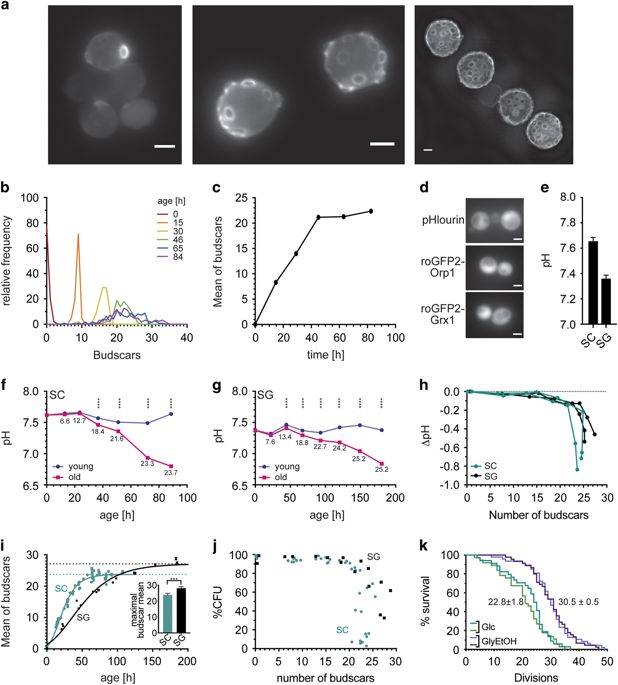npj Aging ( IF 4.1 ) Pub Date : 2016-12-15 , DOI: 10.1038/npjamd.2016.28 Robert A Knieß , Matthias P Mayer

|
What is cause and what is consequence of aging and whether reactive oxygen species (ROS) contribute to this phenomenon is debated since more than 50 years. Notwithstanding, little is known about the cellular buffer and redox systems in aging Saccharomyces cerevisiae, which is a model for aging stem cells. Using genetically encoded fluorescent sensors, we measured pH, H2O2 levels and the glutathione redox potential compartment-specific in the cytosol of living, replicatively aging yeast cells, growing under fermenting and respiratory conditions until the end of their lifespan. We found that the pH decreases under both conditions at later stages of the replicative lifespan. H2O2 levels increase in fermenting cells in the post-replicative stage, but increase continuously with age in respiring cells. The glutathione redox couple becomes also more oxidizing in respiring cells but surprisingly more reducing under fermenting conditions. In strains deleted for the gene encoding glutathione reductase Glr1, such a reduction of the glutathione redox couple with age is not observed. We demonstrate that in vivo Glr1 is activated at lower pH explaining the reduced glutathione potential. The deletion of glr1 dramatically increases the glutathione redox potential especially under respiratory conditions but does not reduce lifespan. Our data demonstrate that pH and the glutathione redox couple is linked through Glr1 and that yeast cells can cope with a high glutathione redox potential without impact on longevity. Our data further suggest that a breakdown of cellular energy metabolism marks the end of replicative lifespan in yeast.
中文翻译:

细胞质谷胱甘肽氧化还原系统的氧化状态与酵母中的复制寿命无关
50多年来,人们一直在讨论老化的原因和后果,以及活性氧(ROS)是否促成这种现象。尽管如此,关于酿酒酵母老化的细胞缓冲液和氧化还原系统知之甚少,酿酒酵母是衰老的干细胞模型。使用遗传编码的荧光传感器,我们测量了在发酵和呼吸条件下生长直至生命周期结束的存活,可复制老化酵母细胞的细胞溶胶中的pH,H 2 O 2水平和谷胱甘肽氧化还原电位区室特异性。我们发现,在复制寿命的后期,两种条件下的pH都会降低。H 2 O 2复制后阶段,发酵细胞中的血红蛋白水平升高,但随着呼吸细胞年龄的增长,其水平不断提高。谷胱甘肽氧化还原对在呼吸细胞中也变得更氧化,但令人惊讶的是在发酵条件下还原更多。在缺失编码谷胱甘肽还原酶Glr1的基因的菌株中,未观察到谷胱甘肽氧化还原对随年龄的减少。我们证明了体内Glr1在较低的pH值下被激活,解释了降低的谷胱甘肽潜力。glr1的删除极大地增加了谷胱甘肽的氧化还原电位,尤其是在呼吸条件下,但不会降低寿命。我们的数据表明,pH和谷胱甘肽氧化还原对通过Glr1连接,酵母细胞可以应对高谷胱甘肽氧化还原电位,而不会影响寿命。我们的数据进一步表明,细胞能量代谢的破坏标志着酵母复制寿命的结束。










































 京公网安备 11010802027423号
京公网安备 11010802027423号